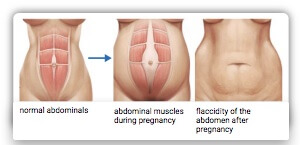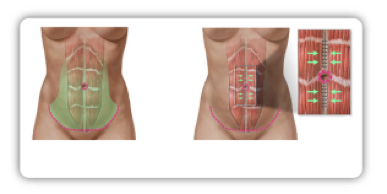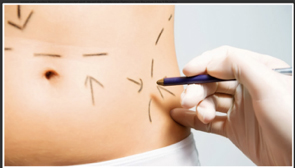Tummy tuck
After pregnancy or an intensive diet as well as natural skin aging, the abdominal wall can become flaccid and wrinkled. Affected people not only feel restricted in their freedom of movement, but often also suffer psychologically because they are ashamed of their appearance. With an operative abdominoplasty, excess skin and fat can be removed and a flat and taut abdomen can be achieved.
ATTENTION: Everyone is unique. This means that the treatment process, planning and outcomes can be different for you. The information you see here is the averages encountered in a large sample size. For details please contact us via WhatsApp: +49 170 5473999
Causes for a flaccid abdomen
The causes of a flaccid abdomen can be many and varied. What they all have in common, however, is that they can no longer be eliminated with regular exercise, diets or superficial cosmetic treatment to the extent that leads to a satisfactory result. One of the causes of a flaccid abdomen is a weak abdomen:
- Pregnancy: During pregnancy, hormones soften the tissues to keep up with the rapid growth of the fetus. The skin on the abdomen is stretched and gains volume within a very short time. After birth, the excess abdominal skin can either no longer be sufficiently repaired or has lost much of its former elasticity. At the same time during the birth process the straight abdominal muscles can diverge (i.e. from one point back to the sides, medically also known as rectus diastasis) and later leave unnatural bulges on the abdomen. Here we can help to restore a taut abdomen with a surgical abdominoplasty and a reconstruction of the straight abdominal muscles.
- Diets: The largest skin folds on the abdomen are often observed in patients who have lost a lot of body fat in the course of a diet. Since the loss of fat is usually faster than the regression of the skin surfaces on the abdomen, in most cases large skin flaps remain behind. Abdominoplasty is used to remove large areas of skin and shape the abdomen in a targeted manner.
- Skin ageing: With increasing age, the elasticity of the skin decreases. This is due to reduced collagen production. In the abdominal area, this can be seen in wrinkled skin areas between the pubic cavity and the navel, often accompanied by light stretch marks. If fat deposits are still stored in the flaccid skin, a so-called "fat apron" may develop. Here a targeted liposuction in combination with a surgical abdominoplasty can form a youthfully firm abdomen.
- Weakness of the connective tissue: The genes determine how tight and elastic the skin on the abdomen is. If the supporting connective tissue on the abdomen is weakly developed, sagging abdominal skin can also occur at a young age. Surgical abdominoplasty can also help here.
Surgical abdominoplasty
We offer patients with flaccid abdominal skin various modern methods that help to achieve a taut and well-formed abdomen. The treatments can be applied individually and combined according to your needs and suitability. The procedure with the most visible results is abdominoplasty, also known as abdominoplasty.
An abdominoplasty is linked to the following prerequisites:
- Your state of health is good and stable
- Before and after the procedure the body weight should remain approximately stable.
- Women who want to have the procedure performed should be sure that they no longer want to become pregnant.
In classical abdominoplasty, excess skin on the abdomen is removed and the edges of the skin are sutured together. Depending on the initial situation, this can be achieved by a large abdominoplasty in which the navel is also removed and replaced. With the mini abdominoplasty, however, the excess skin is only removed in the area between the pubic bone and the navel.
Both procedures are performed under general anesthesia and require a convalescence period of at least 1 week. Despite careful procedures, scars cannot be avoided: However, our surgeons usually plan the incision in such a way that the scars remain as inconspicuous as possible and can be easily covered by clothing.
Large abdominoplasty (full abdominoplasty)
If the tissue and the skin on the abdomen are largely flaccid, the navel has often also sagged. In this case, our experienced experts will recommend a full abdominoplasty, i.e. a large abdominoplasty in which the navel is also moved.
- If, in addition to the slackening of the abdominal skin, there is a large accumulation of excess fat, this can initially be removed by minimally invasive liposuction using cannulas. In this way, the tissue can be strengthened before the actual skin tightening and the general abdominal girth can be reduced.
- One of our experienced surgeons will then make a horizontal incision above the pubic bone. If the flaccidity is more extensive, the incision can be continued upwards along the right and left pelvic bones.
- Furthermore, incisions are also made around the navel, which release it from its original position.
- Once the straight abdominal muscles have moved apart (rectus diastasis), they are straightened in a full abdominoplasty and reattached using internal sutures.
- Then the loosened skin flap is carefully stretched downwards and the excess skin at the lower edge is removed. The navel is now inserted in such a way that a balanced and natural image is created again. The shortened abdominal wall is then sutured again at the edges of the incision.
- In order to ensure the blood circulation of the abdominal wall skin after the procedure, the treated area is first connected with an elastic abdominal bandage and provided with drainage. After a few days, both are removed and replaced by an adapted abdominal corset. This must be worn continuously for up to 6 weeks after the operation in order not to endanger the healing process and to achieve a smooth skin result.
Mini Abdominoplasty
If the slackening of the skin and connective tissue on the abdomen is limited to the area between the navel and the pubic bone, the surgical tightening process only takes place in this area.
- If the slackening is associated with a storage of excess fat (fat apron), a previous liposuction is also carried out here.
- Then the horizontal incision is made directly above the pubic bone.
- The epidermis is stretched downwards and the excess skin at the lower edge is removed. The cut edges are then sutured together.
Other methods - Liposuction of the abdomen
If the abdomen does not have the desired tight and well-defined appearance that you want, increased fat storage in the abdominal area is often the reason. If this is the main reason for the sagging, a minimally invasive liposuction can be sufficient to achieve a tight and well-proportioned abdomen.
For this purpose we offer the gentle liposuction with laser technology via thin cannulas, which liquefy and suck off the abdominal fat. The procedure can be used as an individual therapy or in combination with a full abdominoplasty or mini abdominoplasty. Please discuss the details with the beauty experts.
Procedure of abdominoplasty
- Before the operation you will be thoroughly examined by our surgical staff: They will check your health suitability for the procedure and determine the cause and extent of the flaccid abdomen.
- Our plastic surgeons will then discuss the planned procedure with you. Of course, your individual wishes will also be taken into account. The incision and the skin part to be removed are drawn on the abdomen and discussed with you. Die Schnittführung und der zu entfernende Hautteil werden auf dem Bauch eingezeichnet und gemeinsam mit Ihnen abgestimmt.
- Smoking should be avoided as early as 2 weeks before the operation and the intake of blood-thinning products should be discontinued.
- The duration of the tummy tuck is individual and depends on the extent and number of individual steps required. As a rule, the procedure takes about 3 to 4 hours.
- The surgical abdominoplasty takes place under general anesthesia and is therefore painless. Under certain circumstances, pain and swelling may occur after the operation, which usually subsides quickly.
Risks of an abdominoplasty
Abdominoplasty usually proceeds without complications. Since the treatment is an open surgical procedure that places a considerable burden on the body, certain risks are associated with the treatment. However, our plastic surgeons have a lot of experience in abdominoplasty, so there are usually no complications.
Immediately after the operation, swelling often occurs, but disappears within a few days of the operation without any major development of pain. Wound healing disorders described in the specialist literature, on the other hand, are rather rare and only occur if the operation is performed improperly.
Unlike an abdominoplasty using liposuction, after which you can leave the clinic immediately, an abdominoplasty requires a hospital stay of 1 to 2 days. The absence of sports activities for several weeks after the procedure is conducive to complication-free wound healing and smoothing.
If you wear the specially adapted compression underwear over the recommended period without any gaps, the skin and the underlying tissue will grow together evenly as a rule. While minimally invasive liposuction for abdominoplasty hardly leaves any scars, surgical abdominoplasty can leave inconspicuous scars at the interfaces.



